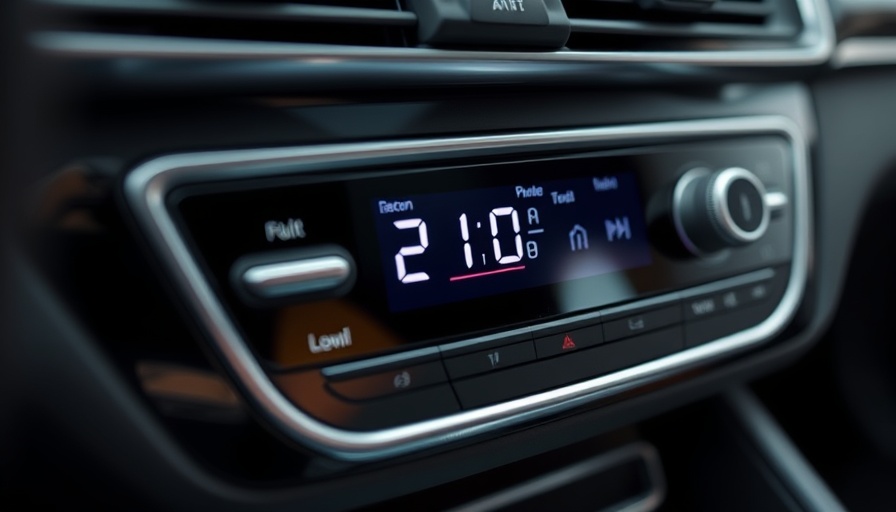
Understanding the Importance of Your Car Seat Rails
Car seat rails often go unnoticed, tucked beneath the seat and out of sight, but they play a crucial role in your driving experience. These metal tracks not only support the seat but also ensure that your positioning remains optimal for safety and comfort. Many states, including Pennsylvania, have strict safety inspections that can flag vehicles with malfunctioning seat rails. An inspection failure often comes down to something as simple as neglected lubrication of the rails, making it essential to keep them in proper working condition.
Why Regular Lubrication Matters
Lubricating car seat rails isn’t just a good habit; it’s a necessary maintenance task, especially for older vehicles. As the average lifespan of cars on the road in the United States climbs to over 12 years, regular upkeep is vital. Not only does lubrication make it easier to adjust your seat without the frustrating squeaks or sudden stops, but it also extends the life of both the seat and the rails.
By lubricating the rails:
- Ensure smoother adjustments: Dust and debris can obstruct the rails, making seat movement difficult.
- Prevent premature wear: Metal-on-metal contact creates friction, leading to faster deterioration if not lubricated.
- Minimize noise: A well-lubricated mechanism reduces unsightly noises when adjusting or shifting.
- Enhance safety: Properly functioning seat rails are crucial during emergencies, ensuring your seating position doesn't shift unexpectedly.
The Risks of Neglecting Lubrication
Failing to lubricate your car seat rails can lead to a range of issues. Over time, drivers may find their seats becoming stiff and difficult to maneuver, which can impede quick reactions in critical moments. Uneven latching mechanisms can render your seat insecure, putting your safety at risk. Furthermore, rails can corrode if they become rusted, resulting in potential repair costs that could easily exceed the price of maintaining your seat's mechanism.
Choosing the Right Lubricant for Your Car Seat Rails
When it comes to lubricating car seat rails, not just any lubricant will do. Opt for products that are designed specifically for similar applications to avoid attracting dust and debris. Look for lubricants that remain stable under various conditions and do not stain or drip.
Here are a few recommended types of lubricants:
- Graphite Lubricants: Ideal for metal-on-metal applications, they reduce friction and do not attract dust.
- Silicone Sprays: These provide a waterproof barrier while allowing for easy seat adjustments without residue.
- WD-40 or Similar Penetrating Oils: Effective for breaking free rusted mechanisms but should be followed up with a more permanent solution.
Practical Tips for DIY Lubrication
Lubricating car seat rails is a straightforward task that requires minimal tools. Before diving in, make sure you gather the right supplies:
- Safety Gear: Use gloves to prevent slippery hands.
- Clean Cloths: For wiping away excess lubricant and preparing the areas.
- Feather Duster or Vacuum: To remove dirt and debris before you apply the lubricant.
1. Begin by adjusting your seat all the way forward to access the rails better. 2. Clean the exposed rail with a cloth, removing dust and grime. 3. Apply your chosen lubricant along the metal tracks. 4. Move the seat back and forth to ensure even distribution. 5. Wipe away any excess lubricant.
How Often Should You Lubricate?
While there's no fixed maintenance schedule, check your seat rails every few months, especially if you drive frequently or in harsh environments. Listen for any unusual sounds, and if you notice decreased movement, it’s time to give them some TLC.
Seize the Opportunity for Comprehensive Maintenance
While you’re under the seat, consider this an opportunity for additional DIY home maintenance. Regular checks on your car can prevent bigger issues in the future. Ensuring that all components, from seat belts to electrical controls, are functioning can enhance safety and comfort while driving.
Conclusion: Elevate Your Driving Experience
A well-maintained car seat rail not only contributes to your vehicle's resale value but also provides safety and comfort essential for every journey. Take the initiative today to check and lubricate your seat rails, preventing future issues and enjoying a smoother ride. When neglected, small tasks can lead to significant challenges—not just for your car but for your overall driving experience.
 Add Row
Add Row  Add
Add 




Write A Comment